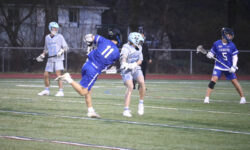[ccfic caption-text format="plaintext"]
By Geena Matuson
Hometown Weekly Staff
Last Friday night, the Medfield Memorial Public Library hosted Urbanologist Max Grinnell, specialist in urban problems, for his talk on “Art in Public Spaces.” As an urbanologist, geographer, historian, and professor, Max teaches at both University of Chicago and at Massachusetts College of Art and Design, focusing on urban spaces, planning and development, community impact - and public art.
When Max walked into the Medfield Public Library, he immediately walked around and took photos on his phone, noting all of the “public art right in this room.” Public art is just like it sounds - art in a public space, available for community enjoyment and, in some cases, interaction. One example of interactive public art Max noted in his presentation is the New England Holocaust Memorial along Union Street in Boston. The memorial is the work of architect Stanley Saitowitz, and is “designed around six luminous glass towers, each reaching 54 feet high, and each lit internally from top to bottom … In addition, millions of numbers are etched in the glass, representing the infamous tattoos inflected on many of the victims’ arms…Six pits are dug and lined with black concrete. At the bottom of each pit is a glowing fire.” The public is able to walk through these glass towers and learn the history behind the piece, and holocaust survivors. This piece was created to combat bigotry and to educate others; if we don’t remember history, we are doomed to repeat it.
Max then spoke on the Bryan Mawr Bricolage, a long, tiled mosaic (or ‘bricolage’) under Lake Shore Drive on Bryn Mawr Avenue in Chicago. This piece of public art was created largely by schoolchildren; children were given historical scrapbooks of Chicago, and were able to choose images and ideas from the scrapbook that they felt represented the city’s history. In fact, the students even assisted in the mural’s creation, gathering bottles to create small tile pieces.
This called attention to a key point about public art: active involvement. In order to sustain public art, maintain interest and grow support, it is necessary to start this appreciation and involvement at a young age. By allowing children to become involved in a community-oriented activity that shines light on art for the public - as opposed to personal - gain, children grow to understand the importance that art holds in our society, and the importance of others with whom we share this society. Public art is everywhere; many may not realize that the decorative clock in the library is public art, or that the decorative details around the doorways are, in fact, also public art. Public art is part of, and contributes to, every day life.
Several large hindrances to public art rise out of this lack of understanding. A general apathy towards the arts is another reason many public art projects are underfunded and go unsupported. To quote Max’s presentation: “Many don’t see the arts as central to the human experience, but are rather meant to be consumed from time to time, much like an expensive wine.” This sadly rings true; in Massachusetts, funding for arts, music and language programs is the first to be cut from any school facing questions of budget and “needs.”
As mentioned above, many locals are concerned with issues of taste-making and private property; many people are more interested in maintaining control over their environment, though the environment in question is invariably shared with others, and this art could benefit the community as a whole. And, as you can’t please everyone, there is often a debate about “community standards.” Many public art projects that do receive funding are therefore watered down, and may have less impact that intended, even if initially contracted by city to create a piece with a specific concept in mind.
Many cities such as Boston are now looking to public alleys as a forum for this art, a process referred to as “Alley Activation.” Cambridge recently dedicated a roughly eight-foot area of wall to ‘tagging’ by graffiti artists. Once the wall is full of art, these artists are in charge of white-washing the wall in order to create a fresh canvas for new public art and use. This new-found interest in “Alley Activation” and other public arts funding programs may spread into smaller cities and towns. This may even revitalize decades-old city-wide statutes that allocate a percentage of construction project funding towards the inclusion of public art, a program still alive in Chicago.
A lively and energetic lecturer, Max’s talk was not only educational, but also upbeat and inspiring. His knowledge informed his powerful words, and this event was a great way to explore history and get an audience interested in public art. If you’re interested in any historical art walks or talks, you can learn more on Max Grinnell’s website at www.theurbanologist.com.








